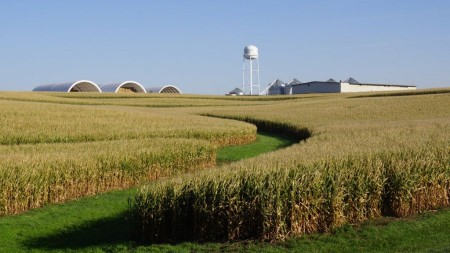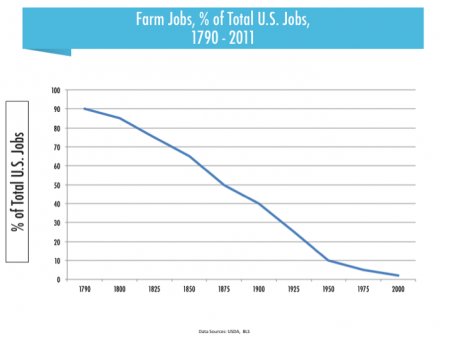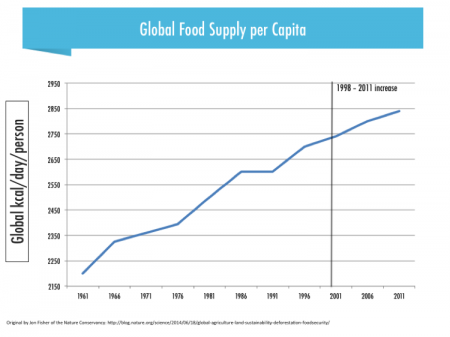April 27, 2015 – This week I received another interesting email blast from Peter Diamandis addressing the future of agriculture and food. I share his observations with you along with my own comments in italics on what I consider to be a very important subject impacting all of us.
———-
Food and agriculture accounts for about 5.9% of global GDP (8% of Canada’s national GDP). Global food retail sales alone account for about $4 trillion/year, and food accounts for 15% of what American households spend each year. (This weekend I read that the average Russian household spends 50% of its income on food.)
It is an industry ripe for disruption. Sensors, networks, machine learning/AI, robotics, 3D printing, synthetic genomics, stem cell science and material science are going to transform how your food is produced, delivered and consumed.
While this arena is going to change dramatically, we forget how much food has changed already over the past two centuries.
And while farming jobs have been lost to automation, the global food supply (per capita) has steadily increased.
As we move towards a world of food abundance, let’s look at a few of the fun areas of transformation and entrepreneurial opportunities.
Food Production:
Bioprinting of Meat: Modern Meadow is a company that uses bioprinting (tissue engineering and 3D printing) to grow meat (beef, chicken & pork) and leathers in a lab. Their vision is to do this at scale and dramatically reduce the environmental impact of meat production. In 2012, it took 60 billion land animals to feed 7 billion humans. In success, bioprinting of meat (beef, chicken, pork) has huge advantages: 99% less land, 96% less water, 96% fewer greenhouse gases, and 45% less energy.
Genetically Engineered Crops: We will increasingly rely on genetically engineered crops. In 1996 there were 1.7 million hectares of biotech crops in the world; by 2010, the number had jumped to 148 million hectares. This 87-fold increase in hectares makes genetically engineered seeds (GEs) the fastest-adopted crop technology in the history of modern agriculture. After 30 years of research, a great many of our fears about genetically engineered products have been quieted. More than a trillion GE meals have been served, and not a single case of GE-induced illness has turned up.
Vertical Farming: We will grow our food in AI-controlled vertical buildings, rather than on horizontal land. Vertical farms will be immune to weather, so crops can be grown year-round under optimal conditions. One acre of skyscraper floor produces the equivalent of 10 to 20 traditional soil-based acres. Employing clean-room technologies means no pesticides or herbicides, so there’s no agricultural runoff. The fossil fuels now used for plowing, fertilizing, seeding, weeding, harvesting, and delivery are gone as well. On top of all that, we could reforest the old farmland as parkland and slow the loss of biodiversity. Companies like FarmedHere, Green Sense, and groups like MIT’s CityFARM are making strides in the field.
Food Production Closer to Home: The average American foodstuff now travels 1,500 miles before being consumed. As 70 percent of a foodstuff’s final retail price comes from transportation, storage, and handling, these miles add up quickly. As a result of vertical farming and genetic engineering, production will become decentralized and distributed, allowing food to be produced nearer to the location of consumption, and the price of food to plummet.
Plant-Based Meat Alternatives: Beyond Meat and Hampton Creek Foods are companies turning plants into foods that look and taste just like meat and eggs. Hampton Creek’s data scientists are actively weeding out billions of proteins from hundreds of thousands of plants to learn what could form the equivalent of a chicken’s egg. The company is seeking to create the largest plant database in the world.
Food Preparation
3D Printed Food: Companies like 3D Systems, Natural Machines, Print2Taste, and others are experimenting with 3D printed food. While 3D printing in chocolates and sugars is well underway, we’ll soon see 3D printed starches, proteins (and even new proteins like algae and insects) and spices.
Personalized Nutrition: Our genome, microbiome, and even our blood type determine how we respond to certain foods/nutrients. Imagine if a 3D printed meal was custom produced depending on the amount of exercise you had that day, and your vitamin blood levels. Advanced biosensing will drive your diet and close the loop.
AI-Designed Recipes: IBM’s Watson uses machine learning to construct new recipes and cocktails that no human chef would come up with. This algorithm matches foods based on extensive taste profiles and the chemical makeup of those edibles in their database. We tried a few of Watson’s cocktails at last year’s A360: Hoof-n-Honey Ale (veal stock, grilled beef and IPA), Plum Pancetta Cider (bacon and cider), and Corn in the Coop (old fashioned with chicken).
Food for Fuel, Not Pleasure: For those that opt-in to optimize their consumption (often at the expense of “taste”), we will have mixtures that will provide us with exactly what our bodies need in terms of nutrients, carbohydrates, protein, and more. Companies like Soylent and Ambronite are already doing this. These options will be cheaper and faster than traditional consumption practices – and they will feed many who don’t have access to food at all.
Food Delivery
Food On-Demand: Press a button and food will be at your doorstep in minutes. PitchBook Data reports that companies involved in delivering groceries and meals in the region attracted $433 million in funding last year. That’s up from about $68 million in 2013 and only about $21 million in 2012. Companies like Uber Fresh, Munchery, and many others deliver high-quality, restaurant and chef-prepared food to your doorstep on demand.
———-
Much of what Peter describes expresses a strong American bias. It also ignores the impending challenges brought on by climate change. I would think this has to be part of the conversation. Is the U.S. model one that replicates globally. Canada with its much smaller population and different geography has a very different agribusiness with the majority of farm output going to export, not domestic consumption. In addition Peter doesn’t address the issue of freshwater scarcity, a growing problem not only in the United States but in much of the Developing World. Nor does Peter address food wastage, one of the greatest challenges agribusiness faces today globally.
In several past postings on this site I have written about the food that farmers grow that never gets to hungry mouths. Many countries lack an adequate supporting agribusiness infrastructure. Inadequate roads and transport means harvested crops never get to market. Lack of energy in rural areas means farms cannot refrigerate or adequately preserve what they grow. Even on-site storage facilities are insufficient or poorly designed to ensure what gets harvested can ultimately be eaten before it rots.
Today the amount of annual spoilage because of these issues is as if 28% of all arable land annually is taken out of production globally. This wastage further exacerbates global warming by contributing 3.3 gigatons of carbon dioxide and other greenhouse gases to the atmosphere annually and when calculated amounts to an annual contribution of CO2 weighing 500 kilograms (1,100 pounds) per person.
In juxtaposition to Peter’s view of agribusiness and food production I give you my own take on its future in the 21st century, a posting I wrote back in October 2012 entitled, “Will We Run Out of Food for Our Growing Population in the 21st Century?”






















[…] https://www.21stcentech.com/agriculture-industry-ripe-disruption/ […]
[…] farms will be immune to weather, so crops can be grown year-round under optimal conditions. [26] Vertical farms are also sprouting up in Europe and Asia, including in Singapore and Japan, where […]